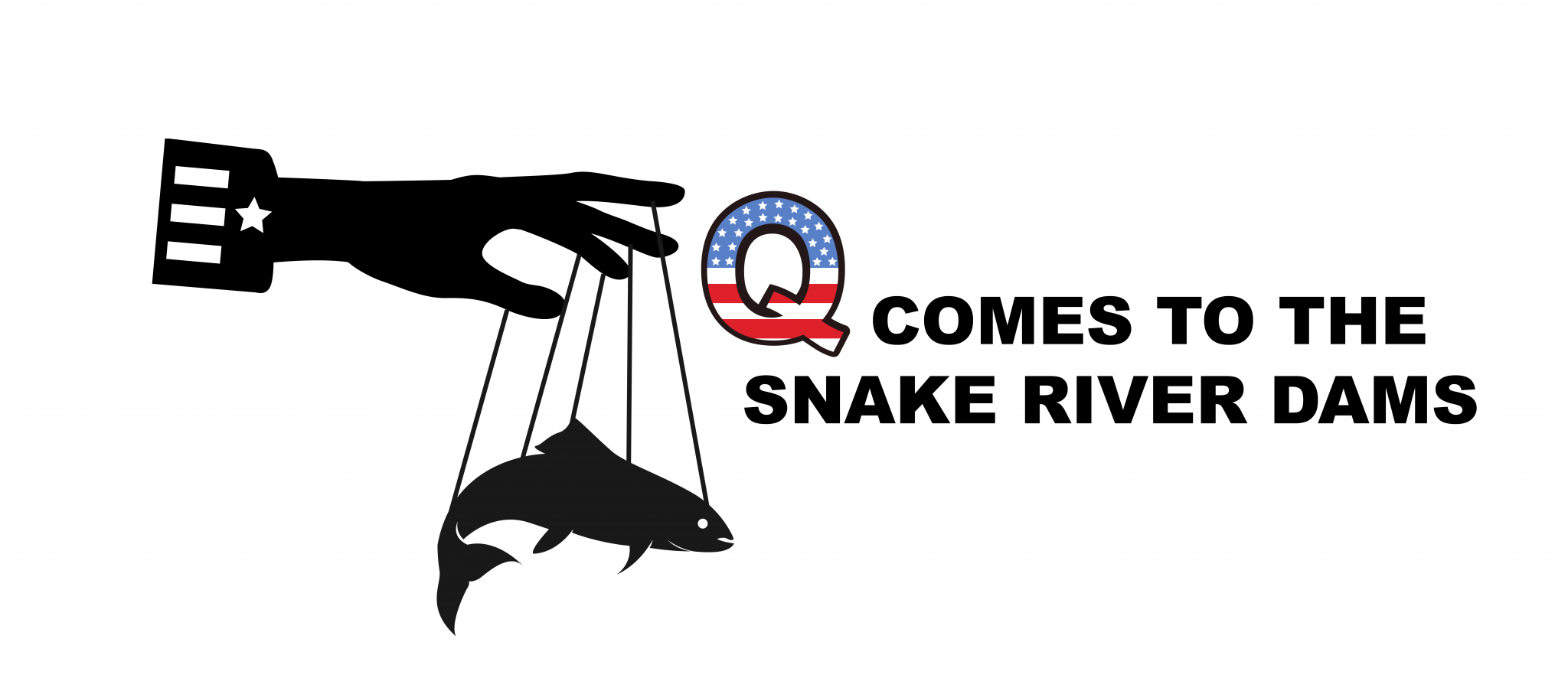
The biggest obstacle to breaching the dams isn’t salmon or hydropower. It’s our reflexive cultural division
By Chuck Thompson. April 8, 2021. A bizarre email arrived in my inbox last week. Its subject was those four infamous dams along the Lower Snake River in Washington.
Crazy as it was the email nevertheless impressed me for raising a long-neglected issue in the fight over the dams, one that’s been ignored by the army of politicians, business leaders, interest groups, media and bric-a-brac experts that’s devoted millions of hours to analyzing, explaining and debating the dams in recent decades.
The argument over whether or not to breach the dams may be the most contentious environmental issue facing the Pacific Northwest this decade, climate change included. If you’re opposed to their existence, the dams are salmon-killing machines. If you’re in favor of keeping them intact they’re vital pieces of the region’s hydroelectric and shipping infrastructure. Or so goes conventional wisdom.

Rep. Mike Simpson. Courtesy of Office of Rep. Mike Simpson
Since last year, Columbia Insight has covered the debate in a series called 140 Miles: Snake River Stranglehold. We’re hardly trail blazers. Tribes, fishermen, conservationists and other groups have protested the dams in court and in the streets since even before the U.S. Army Corps of Engineers built them in the 1960s and ’70s. Lots of good reporting has tracked the ensuing controversy.
A lot of the serious recent thought has revolved around a 2019 economic impact study on breaching the dams commissioned by the late Paul Allen. YaleEnvironment360 followed that study with, from a crowded field, one of the better short summaries of the argument to breach. The Bonneville Power Administration, which markets the power generated by them, countered with its own missives explaining the benefits of the dams. A pair of Oregon filmmakers followed with a powerful documentary titled Dammed to Extinction that examines the dams’ disastrous impact on Salish Sea orcas.
In February of this year U.S. Representative Mike Simpson rolled out what may turn out to be a game-changing plan to settle the matter once and for all. Because Simpson is a Republican from the conservative bastion of Idaho his Energy & Salmon Concept, which calls for breaching all four dams to the federally funded tune of $33 billion, arrived as a thunderbolt to dam opponents (generally politically liberal), supporters (generally politically conservative) and any forsaken souls in between.
[perfectpullquote align=”full” bordertop=”false” cite=”” link=”” color=”” class=”” size=””]The dams war is a quagmire because at its heart it’s a philosophical struggle, not an economic or environmental one.[/perfectpullquote]
I’ve burned a decent chunk of my retinas over the past year keeping up with developments. Plowing through news summaries, white papers, dueling press releases, legal briefs and other media (I’ve watched Dammed to Extinction three times), I eventually landed on an unsettling epiphany: although efforts to explain the dams tend to be well researched and clearly presented, none ever gets around to addressing the central conflict that animates the entire argument.
Cue bananas email. Its subject line read: URGENT: REPORT CONCERNING THE TRUTH ABOUT IDAHO’S SALMON VS DAM BREACHING.
The email and attached “report” was sent by a self-described “honest hard working grandma who loves Idaho.” It ran nine pages. Single-spaced. With liberal (small “l”) use of exclamation points providing ballast amid a sea of all-caps shouting.

“The Northwest deserves to know the TRUTH and that we’ve all been LIED TO.”
“IT’S NOT THE DAM’S FAULT! America, please! Aren’t there any HEROES left out there who can save our Northwestern ROYALTY fish from their TYRANNICAL EXTINCTION FATE while being denied their right to reproduce?”
“Pray that I’m not assassinated. I’m hitting FEDERAL corruption with their DIRTY SECRETS below the belt.”
“WHITE LIVES DON’T MATTER to Simpson?”
“I know a hundred heavy-equipment operators who will fight for the honor to do the volunteer work needed to FREE Idaho’s suffering fish from these FEDERAL AUSCHWITZ-BIRKENAU DEATH TRAPS.”
MORE: “The stars are aligned”: Rep. Mike Simpson breaks down plan to breach Snake River dams
It took time to select a handful of representative lines from Idaho Grandma’s splenetic rant, which pounds home the point that dams and salmon can thrive together if only we could stop the secret salmon holocaust being perpetrated by the federal government.
The reasons for this government plot aren’t precisely articulated but they definitely involve an elite cabal lining its pockets with billions of dollars in salmon-carcass bounties.
In fact the quotes are interchangeable. I could have closed my eyes and pointed at any sentence in Idaho Grandma’s freeform screed—“If you hear that I committed suicide, don’t believe it and know that it’s a lie”—and they’d more or less read the same.
To those of us still living in Normalland, her cult-like homily comes across as a now all-too-common example of the alarming weltanschauung that’s taken hold of people living in an inexplicable self-exile of conspiratorial delusion untethered to reality.

Kathy’s Rusty Relics. Photo by Chuck Thompson
Its primary argument may reside far from the end of the ten-foot pole that until recently rational society wouldn’t bother touching it with.
To its credit, however, the email is the first committed reflection I’ve come across that confronts the real reason the dams debate is so intractable.
For all the hot oratory it attracts, the primary impediment to solving the Lower Snake River riddle isn’t really about finding a compromise between fish and electricity needs, or mollifying farmers who need to move product downriver. Most everyone knows dams are bad for salmon, redundant hydropower projects are money losers and, in the absence of barges, that there are more than enough trucks and trains around to move grain from Idaho to Portland.
The dams war is a quagmire because at its heart it’s a philosophical struggle, not an economic or environmental one. Writ large it represents simply another piece of the culture war that’s divided the nation into polarized factions. Regionally, it’s a reflection of the cultural maw and football mentality that’s developed between communities on the east and west sides of the Cascade Range. What one side wants, the other is honor-bound to oppose.
Although its QAnon-style rhetoric introduces a somewhat stronger flavor, the give-me-dams-or-give-me-death email from Idaho Grandma sums up a certain workaday attitude toward the western neighbors that’s become entrenched on the east side of the Cascades.
 It’s been a quarter century since the publication of Blaine Harden’s A River Lost: The Life and Death of the Columbia. At a brisk 245 pages, Harden’s book stands as the seminal explanation of how the raging and occasionally terrifying waters of the Columbia River Basin—the Snake River is its largest tributary—were transformed into a placid network of more than 250 slackwater reservoirs created by hydroelectric projects, 27 on the Snake alone.
It’s been a quarter century since the publication of Blaine Harden’s A River Lost: The Life and Death of the Columbia. At a brisk 245 pages, Harden’s book stands as the seminal explanation of how the raging and occasionally terrifying waters of the Columbia River Basin—the Snake River is its largest tributary—were transformed into a placid network of more than 250 slackwater reservoirs created by hydroelectric projects, 27 on the Snake alone.
When Lewis and Clark arrived at the confluence of the Snake and Columbia Rivers in October 1805, it was spawning season. The party counted salmon in the hundreds of thousands, 10,000 drying on racks in one Native village alone. Drop the old frontiersmen in the area today—indeed anywhere along the Columbia—and they’d have no idea what they were looking at.
Re-reading A River Lost last year I was impressed not only with its retelling of the river’s remarkable history but by how prescient Harden seemed to have been about 21st-century attitudes toward the dams—until I realized he wasn’t prescient at all. In his travels through the Basin Harden was simply describing a culture war already in full throat.

Blaine Harden. Penguin Random House
Aligned against a growing army of environmentalists and “fish people” from west of the Cascades, Harden found barge crews who “did not pretend to care about endangered species,” federal planners who believed “that the present salmon run must, if necessary, be sacrificed” and Limbaugh-loving farmers who felt “betrayed by our own country” for revisions to New Deal irrigation programs the region had plainly outgrown.
After finishing the book I called Harden at his home in Seattle to ask if he saw any way out of the gridlock.
“Seattle and Portland have become even more of what they were 25 years ago,” he told me. With the emergence of Microsoft, Amazon, Nike and other companies, he went on, the Northwest’s dominant population centers have accumulated even more overwhelming economic and political clout than they had in the 1990s when he’d written his book.
The consolidation of commercial power and electoral influence on the rainy side of the mountains has been met in equal measure by cultural resistance on its dry side. This feels like a predictable if not natural reaction, to me, even if its most outward expressions are often repellant.
Drive along U.S. Route 12 in Washington and in the small community of Glenoma (technically on the west side of the mountains, spiritually somewhere between MAGA and Boise) and you’ll pass a little antique shop called Kathy’s Rusty Relics. It’s festooned with Confederate flags and signs proclaiming things like “Inslee T-Yrant and scumbag” and “King County—Home of the Beast.”
MORE: The Other Oregon: Book reveals rarely seen side of Eastern Oregon
This past fall I spent a couple days in Joseph in eastern Oregon, where I was accosted not once but twice by strangers who didn’t just sneer at my face mask, they explicitly instructed me to remove it.
“We don’t wear those here,” the guy pumping my gas told me with righteous contempt. “You take that off when you’re here.”
I gave as casual a shrug as I could manage and said I was just following the rules. “Those rules don’t apply here,” he told me.
There was a weird standoff. When the gas pump eventually clicked off it sounded like someone de-cocking a pistol. I’m sure he missed my company as much as I missed his.
 Just as A River Lost is the best explanation of how the mighty Columbia became a hydroelectric warhorse that helped win World War II and make the world safe for Pumpkin Spice Lattes, Kurt Anderson’s 2017 bestseller Fantasyland: How America Went Haywire, is the seminal account of how the United States has devolved into a society in which one side lives in reality and the other in a world dominated by what Anderson calls “magical thinking.”
Just as A River Lost is the best explanation of how the mighty Columbia became a hydroelectric warhorse that helped win World War II and make the world safe for Pumpkin Spice Lattes, Kurt Anderson’s 2017 bestseller Fantasyland: How America Went Haywire, is the seminal account of how the United States has devolved into a society in which one side lives in reality and the other in a world dominated by what Anderson calls “magical thinking.”
The ennobling of “alternate facts” has propelled the paranoid, angry and conspiracy-minded from the fringes of society into the mainstream. January 6 proved not just that they must no longer be ignored, but taken seriously.
MORE: Electric cars and dams: An uncomfortable connection
“By my reckoning, the more or less solidly reality-based are a minority, maybe a third of us, but almost certainly fewer than half,” Anderson writes in his introduction, setting up what turns out to be a pretty thorough and convincing case supporting his depressing thesis.
I finished Fantastyland the same week HBO premiered Q: Into the Storm. The documentary series investigates the malign foundation of the QAnon movement, which has morphed from dada propaganda prank to ongoing experiment into how credulous (gullible, if you like) people pre-disposed to rhetorical apoplexy and tribal warfare can be.

Then the email from Idaho Grandma arrived. I printed out the attachment and read it with yellow Hi-Liter in hand: “Hang your head low DC FEDS before the public decides to hang your heads high. … The whole decrepit Salmon-Killing Empire NEEDS BURNED TO THE GROUND. … Consider this as your ammo.”
The author provided her name and a headshot of herself along with permission to publish both with the entire manifesto. Prudence prevailed.
Although I’d like to believe things really aren’t as bad as the MSNBC/CNN/FOX/OAN machine makes them out to be, the gulf between those who believe in honest debate and compromise and those that hew to magical thinking and obstructionism often feels insurmountable.
As that relates to the Lower Snake River, I’ve come to the conclusion the key part of the argument no longer revolves around salmon, hydropower, irrigation, grain farmers, barge jobs or any of the other arguments we keep wasting our breath on.
If people really want to get rid of those dams, they’re going to have to ford a current so powerful and a breach so wide it’d make Lewis and Clark wonder how the hell they were going to make it across.
Chuck Thompson is editor of Columbia Insight. Illustrations by Mackenzie Miller.
The views expressed in this article belong solely to its author and do not reflect the opinions of anyone else associated with Columbia Insight.
Columbia Insight‘s series focusing on the Lower Snake River dams is supported by a grant from the Society of Environmental Journalists.
READ MORE SNAKE RIVER STRANGLEHOLD STORIES







